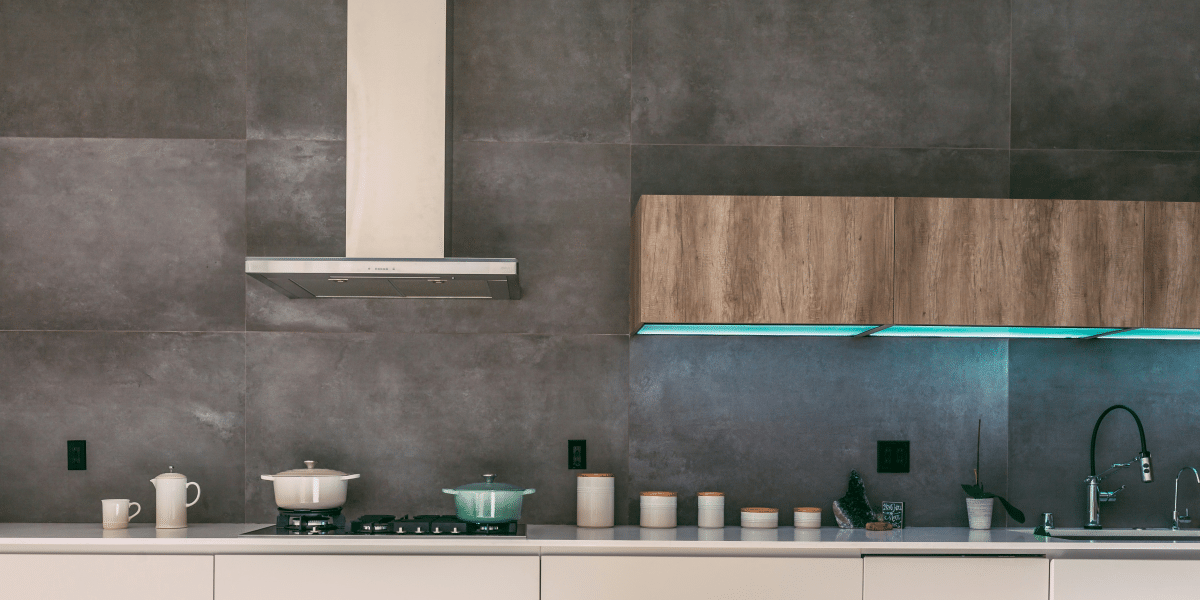Every kitchen needs a ventilation system to handle smoke, smells, and heat for a better cooking experience. This guide explains important things to consider when picking a kitchen ventilation system. Having good ventilation not only keeps the air clean but also makes cooking in your kitchen more pleasant.
Factors to consider when choosing kitchen ventilation system
Here are some key factors that you should consider before selecting an ideal ventilation system for your kitchen.
Types of ventilation systems for your kitchen
Downdraft ventilation
A downdraft ventilation system is the right choice for a kitchen with a cooktop on islands. You can install the system into your countertop and run a fan to let the air move downward. It will efficiently capture fumes and smoke in your kitchen. Moreover, downdraft ventilation, being a discreet and sleek system, matches the overall setup in a modern kitchen.
Range hoods
A range ventilation hood hangs above your cooktop or stove to remove fumes and airborne grease. The main purpose is to vent cooking odors and heat to the outside. Range hoods are available in ductless and ducted versions.
- A ducted hood expels the odors and smoke outside.
- A ductless system helps with air filtration and recirculation in your kitchen. Although it is not very efficient, a ductless hood is a good choice if you cannot consider external venting.
Ducted hoods provide better superior ventilation; however, they need an external pathway.
Among the many options available for range hoods, copper range hoods are known for adding aesthetic value to your kitchen room. Moreover, copper is known for its energy efficiency and antimicrobial properties. The metal makes the hoods durable and saves your repair costs.
Wall-mounted fans
Budget-friendly wall-mounted fans pull the air and expel it to the outside of your kitchen. Although they are not highly effective, you will find improved air quality.
Check the venting strength
Cubic feet per minute is the unit used to measure the performance of the kitchen hood. The higher CFM rating means the system can take away more air in the shortest time. The CFM depends on the type and size of your range top. It also varies with the frequency of your cooking activities in your kitchen. For example, a 6-burner gas range needs more venting strength than a standard 30-inch electric cooktop. Most cooktop manufacturers mention the CFM needed for your range hood.
Ensure a low sound level
Noise generated by kitchen hoods is measurable in sone. So, you should choose a hood with minimal sone level, especially in homes with an open layout (the kitchen merges with the living area). Many innovative models allow you to manage the noise level depending on your needs. Although higher CFM systems are powerful, they tend to be louder.
Decide on the mounting height
What should be the distance between the burners and the range hood? It is recommended to maintain a gap of at least 30 inches between the countertop and the hood. Another important thing is that a hood fitted higher up your wall can cause a reduction in the venting power.
Invest in the ideal filters
Choosing the right air filter is important for achieving the ideal result. Grease filters capture grease particles generated during your everyday cooking. They prevent grease from accumulating in your ductwork. On the contrary, charcoal filters remove smells from the indoor air. If you regularly cook meals with strong-smelling ingredients, charcoal filters are the right choice. You do not need to clean them regularly; however, they need replacements after every few months. Another option is the mesh filter, which quickly deteriorates and is not easy to clean.
Having kitchen ventilation is vital to keep your kitchen area clean from air pollutants, smoke and odors. By making informed choices based on these factors, you can enhance the functionality and comfort of your kitchen space.
Published by: Holy Minoza


















